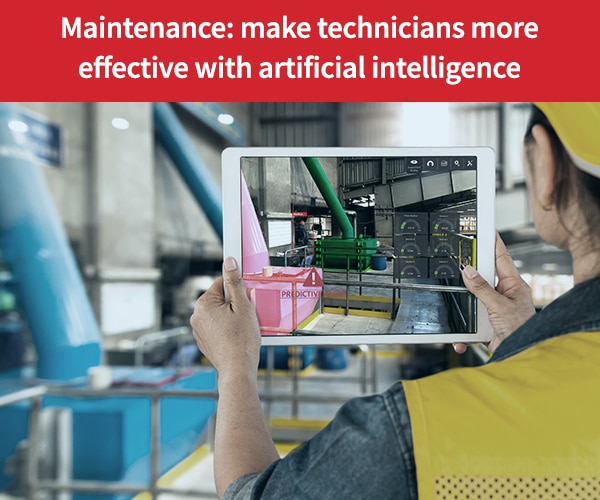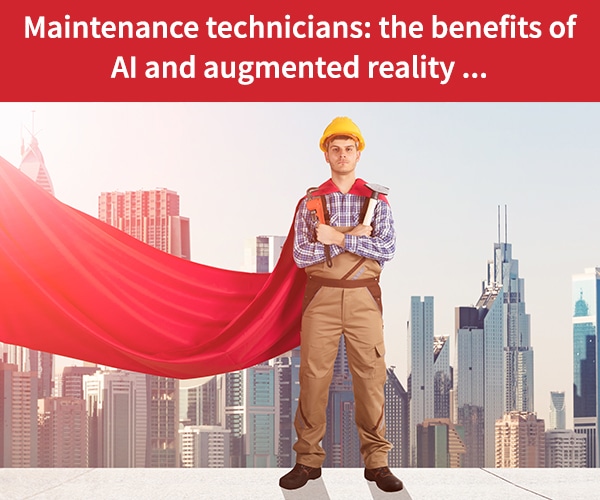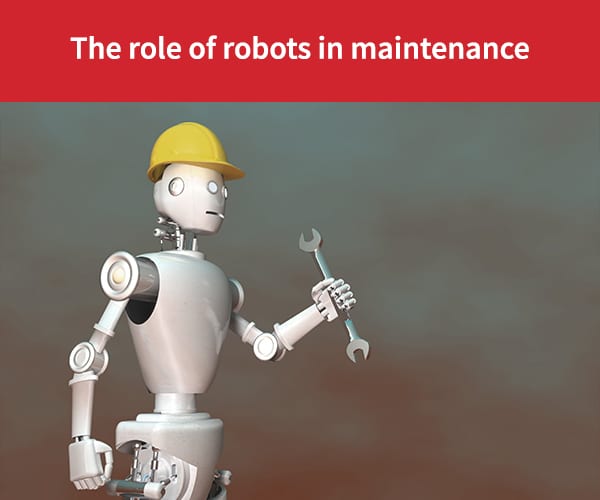
- Artificial Intelligence
- Maintenance
- Technician
- Technicien
Bringing the benefits of computer vision to maintenance technicians
Computer vision uses artificial intelligence technologies to automatically detect defective components. It “augments” on-site maintenance technicians who are equipped only with a smartphone. You’ve likely used a computer vision service without knowing it. As a sub-category of artificial intelligence, computer vision technology processes and analyzes images and videos to learn from them. This artificial vision is often used to identify individuals in photos posted on social networks. To “see” like humans, computer vision relies on image processing and deep learning technologies through neural networks. In today’s digital world, this image data permeates our daily lives and the use cases are endless, especially in the professional world.
Computer vision has many practical applications
With video surveillance, a camera that’s connected to artificial vision technology can automatically detect an attempted break-in at a private residence, an assault in a parking lot, a piece of abandoned luggage in an airport, a person who has collapsed on a subway platform or aggressive behavior on public transportation. And it can do this with all of the legal and regulatory safeguards required to protect peoples’ right to privacy. With the advent of connected and autonomous cars, auto manufacturers will swap out electronic sensors for smart cameras to minimize the risk of accidents. The on-board system continuously analyzes the flow of visual data from objects such as road signs and measures the distance to other vehicles and to pedestrians to make the right decisions at the right time. Computer vision also has great potential for:
- Medical imaging in healthcare
- Optimizing shelving in warehouses
- Crop disease detection using aerial photos in agriculture
- Track monitoring using drones in the railway industry
Quality control and predictive maintenance are enhanced
But it’s industrial players that have the most to gain from computer vision, especially in the area of quality control. A camera with image recognition that’s installed above a production line can immediately detect faulty parts, relieving production staff of this thankless task. Computer vision is also very useful for automated inspections of infrastructure and buildings. In predictive maintenance, computer vision can be used to identify a problem or failure before it occurs. Because the computer can endlessly manipulate image data in an objective way without ever getting tired, it can far exceed human capabilities, saving significant time and providing very low error rates.
Analytical maintenance is now possible
Once the image data is captured by the camera, it’s sent in real time to software that analyzes it and provides recommendations, such as initiating preventive maintenance when significant wear is detected on a part. We call this “analytical maintenance”. For Augustin Marty, CEO and co-founder of Deepomatic, a startup that specializes in developing image recognition solutions for manufacturers, computer vision is ideal for service management. In a column published on the French website, L’Usine Nouvelle, Marty explains that equipping technicians’ smartphones with a visual recognition application allows them to photograph each step of their installation or maintenance task to benefit from real-time notifications about the right approach to take until the work is completely validated. He then notes that “augmented technicians” save time and, thanks to the information in the application, improve the quality of their work over time. If technicians never need a return visit to readdress an issue, customers also benefit.
The energy industry benefits
As an example, the startup founder cites the need to read and maintain gas, water and electricity meters, tasks that citizens typically dread. The problem is the large number of connection errors and the mess this creates. In addition, rearranging dates can be like running an obstacle course. These rescheduled service calls are expensive for utility operators. And it’s very difficult to keep an eye on all of the work carried out by subcontractors acting on their behalf across the country. In another column for L’Usine Nouvelle, Augustin Marty highlights a use case for electricity providers: “intelligent” inspection of utility poles. If these poles are poorly maintained, or become corroded, they can cause blackouts and, in heavily forested areas, forest fires. Today, utility pole inspections are carried out by people who climb the poles and visually assess whether metal supports are corroded, or by visually inspecting photos taken by drones to determine the degree of corrosion. Considering the number of photos that must be processed, evaluations are made back at the office, not on site. Computer vision allows the data to be automatically processed in real time. It even classifies the corrosion level of metal supports as surface corrosion or puncture corrosion.
The telecom industry benefits
The energy industry is not the only one affected. Telecom operators can also use computer vision. French telecom provider, Bouygues Telecom, uses a Deepomatic quality control solution for technicians that connect fiber at customer sites. Technicians use their smartphone to take pictures of the device to be connected. The photos are sent to the cloud and analyzed by an image recognition neural network that detects anomalies such as a disconnected fiber line or a transmission fault in a cable. If a definitive determination can’t be made, the software sends an alert to the technician so they can make the final call. French national railway company, SNCF, also relies on computer vision technology to significantly increase rail safety. For the past five years, the company has been working with the technology in the areas of driving assistance, operating assistance, safety and passenger counting.
Our similar articles.
-
- Productivity
- Technician
- Artificial Intelligence
- Mobile App
How AI and augmented reality give maintenance technicians super powers
February 5, 2019 -
- Customer Satisfaction
- After-sales service
- Artificial Intelligence
- Work orders
- Customer satisfaction
Humanizing customer service in a digital world
September 2, 2020 -
- Maintenance
- Work orders
- Technology
Using maintenance robots
June 17, 2020


